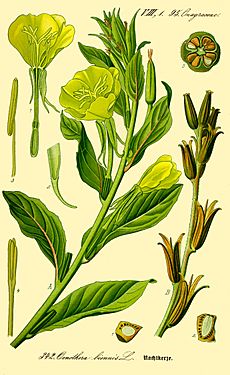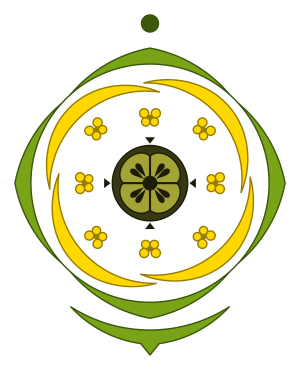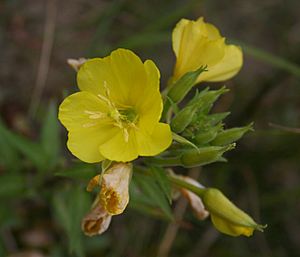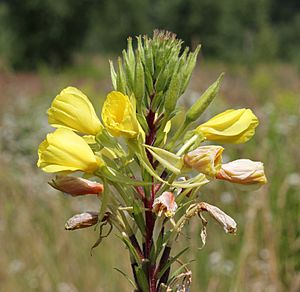Common evening-primrose facts for kids
Quick facts for kids Common evening-primrose |
|
|---|---|
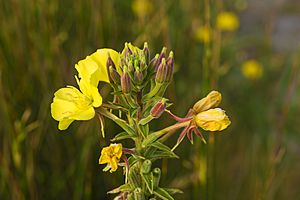 |
|
| Scientific classification | |
| Genus: |
Oenothera
|
| Species: |
biennis
|
| Synonyms | |
|
|
The common evening-primrose, also known as Oenothera biennis, is a type of flowering plant. It belongs to the Onagraceae family. This plant originally comes from eastern and central North America. You can find it from Newfoundland all the way to Texas. It has also spread and now grows in many other warm and mild parts of the world. A special oil called evening primrose oil is made from this plant.
People call this plant by many other names too. Some of these names are evening star, sundrop, weedy evening primrose, German rampion, hog weed, King's cure-all, and fever-plant.
Contents
Description
The common evening-primrose is a biennial plant. This means it lives for two years. In its first year, it grows a tight bunch of leaves close to the ground. This bunch is called a rosette. The leaves are long and narrow, about 8 to 18 centimeters (3 to 7 inches) long.
In its second year, the plant grows a tall stem. This stem can reach up to 1.6 meters (5 feet) high. The leaves grow in a spiral pattern on this stem.
Flowers
The flowers of the evening-primrose bloom from late spring to late summer. They grow on the tall stem. Each flower has both male and female parts, meaning it is hermaphrodite.
A cool thing about these flowers is how they open. They open very quickly every evening. This is why the plant is called "evening primrose." The flowers only stay open until the next morning.
The blooms are yellow and about 2.5 to 5 centimeters (1 to 2 inches) wide. Each flower has four petals. These petals are bilobed, which means they look like they have two small parts. The flowers also have a special pattern that helps pollinators. This pattern guides insects to the nectar. Humans cannot see this pattern, but moths, butterflies, and bees can see it under ultraviolet light.
Fruit and Seeds
After the flowers, the plant produces a fruit. This fruit is a capsule. It is about 2 to 4 centimeters (0.8 to 1.6 inches) long. The capsule contains many tiny seeds. Each seed is only about 1 to 2 millimeters long. When the capsule is ready, it splits into four parts. This releases the seeds.
The seeds are an important food source for birds. The plant is also a host for certain insect larvae. For example, the primrose moth and the white-lined sphinx moth lay their eggs on it.
Uses
For many centuries, Native American tribes have used the common evening-primrose. They used it both as food and as traditional medicine.
The plant was brought to Europe in the early 17th century. It was first grown in gardens because of its pretty flowers. These flowers are great for pollinators because they produce a lot of nectar. The seeds also provide food for birds.
Food Uses
Most parts of the evening-primrose plant can be eaten. They have a mild taste.
- The roots can be eaten raw or cooked. They are often prepared like potatoes.
- The leaves can be added raw to salads. You can also cook them like spinach or use them in soups.
- Some Anishinaabe tribes traditionally made tea from the leaves. They used this tea to help with diet and to feel less tired.
- The flowering stems are best eaten when they are young, usually in June. You need to peel them first. After peeling, you can eat them raw or fry them.
- The flower buds are considered a special treat. You can pick them from June to October.
The seeds of the plant are also very nutritious. They contain about 15% protein and 24% oil. These proteins are rich in certain amino acids. The oil from the seeds contains special fats called gamma-linolenic acid (GLA) and linoleic acid. These are polyunsaturated fatty acids. Because of these healthy fats, evening primrose oil is sold as a dietary supplement.
Traditional Medicine
The common evening-primrose has a long history in traditional medicine. The whole plant, especially the leaves, was often boiled to make a tea. Anishinaabe tribes used this tea to boost energy and help with weight loss. They also used the roots in other ways. For example, they would make a poultice (a soft, moist mass) from the roots. This was placed on the skin to treat piles and boils. Sometimes, the roots were chewed and rubbed onto muscles to make them stronger.
Growing Evening-Primrose
We are still learning a lot about how to grow evening-primrose. Most of what we know is about growing it for its seeds to make oil. We don't know as much about growing it for other parts, like its roots.
Where it Grows Best
The evening-primrose likes sunny, dry places. It grows well in loamy soil, which is a mix of sand, silt, and clay. It usually grows below 700 meters (2,300 feet) above sea level.
One important thing for growing this plant is enough nitrogen in the soil. Too much nitrogen can make the oil in the seeds less good. But just the right amount of nitrogen helps the seeds grow better and produce more oil.
Planting and Care
Evening-primrose seeds need light to sprout. So, it's important not to plant them too deep in the soil. About 0.5 to 1.0 centimeter (0.2 to 0.4 inches) deep is usually enough. This makes the plant good for no-till farming, where you don't dig up the soil much. However, the plants need a lot of help to control weeds.
The seeds are very tiny, weighing about 0.3 to 0.7 grams (0.01 to 0.02 ounces). They take about two to three weeks to sprout. During this time, they are very sensitive to weeds growing around them.
You can plant evening-primrose seeds in two main times:
- Spring seeds: Plant in the first half of April.
- Autumn seeds: Plant from mid-July to mid-August.
The harvest time depends on when you plant them. Spring seeds are ready in about 75 to 80 days after flowering. Autumn seeds take about 100 days. The exact time also depends on the plant type, weather, and soil. It can be tricky because not all seeds ripen at the same time.
Water and Other Benefits
The evening-primrose does not need a lot of water as it grows. Studies have even shown that watering it with salt water can increase the amount and quality of oil in the seeds. This is exciting because it means the plant could be a good crop in dry areas where fresh water is limited. It could be a valuable new oil crop for these regions.
Important Considerations
It's important to manage evening-primrose fields carefully. If not, the plant can spread too much and become invasive. Also, if the seeds are used for medicines, it's very important to grow the plants without any pesticides. This makes sure there are no harmful chemicals left on the seeds.
See also
 In Spanish: Onagra común para niños
In Spanish: Onagra común para niños


